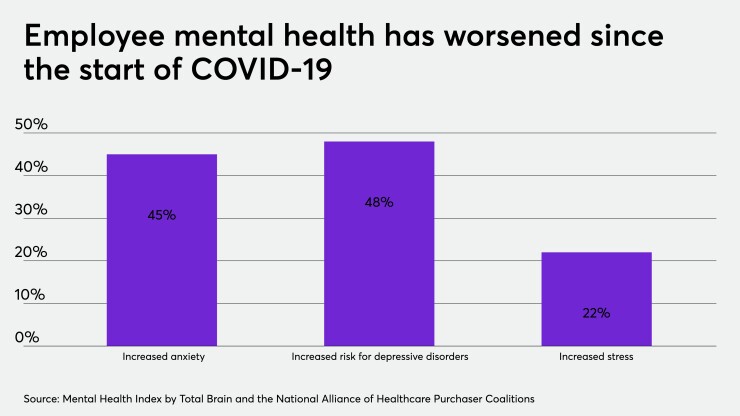Mental health is at an all time low for employees, creating an additional crisis for employers struggling to address the challenges of COVID-19.
Employees reported a 48% increase for risk of depression between November and December, according to the Mental Health Index by Total Brain and the National Alliance of Healthcare Purchaser Coalitions. Additionally, overall employee focus plummeted 62% during that same time — the highest drop since last February.
Between March and November, employees’ mental health had steadily improved, as workers adjusted to the
“We are seeing an unprecedented rise in risk of mental health conditions,” Louis Gagnon, CEO of Total Brain, said in a statement. “This is a crisis that should alarm everyone in the business community. Business policies designed to support the mental health of employees are essential.”
Despite positive news
Holiday stress, political uncertainty and
“A year into the pandemic, it is hard to focus and not to be depressed,” Garen Staglin, chairman of One Mind at Work said in a statement. “Employers have an obligation to identify new ways to support the mental health of their workforce.”
Read more:
In the United States, one in five employees struggles with a mental health disorder, according to the National Institute of Mental Health. Poor mental health is predicted to cost employers nearly $6 trillion dollars by 2030, according to the World Health Organization.
It’s critical employers address these issues before they
“It's difficult when someone has an emerging health issue to not jump to the conclusion that it's a performance issue,” Tugman says. “Take time to train managers to know what these signs look like and how to address them.”
Employers have made strides in offering benefits that address mental health issues: 91% of organizations offer an EAP with a mental health component, according to the Society for Human Resource Management. Employers including Starbucks, Lyra Health and Bank of America have all expanded their benefit offerings to include free access to therapy and other clinical tools.
Read more:
Two-thirds of employees hide their mental health condition at work because of fear and stigma, according to a study by Mind Share Partners, SAP, and Qualtrics. Allowing employees to have an open dialogue around mental health and encouraging the use of available benefits can help employees get the help they need, Tugman says.
“It's OK to not be OK. Fear, anxiety, anger, isolation, feeling irritable, feeling anxious — all of that is normal, and we have to be able to have the conversation,” she says. “The only way we're going to get at it is to raise awareness, minimize stigma and increase access to care to get people the help they need.”






